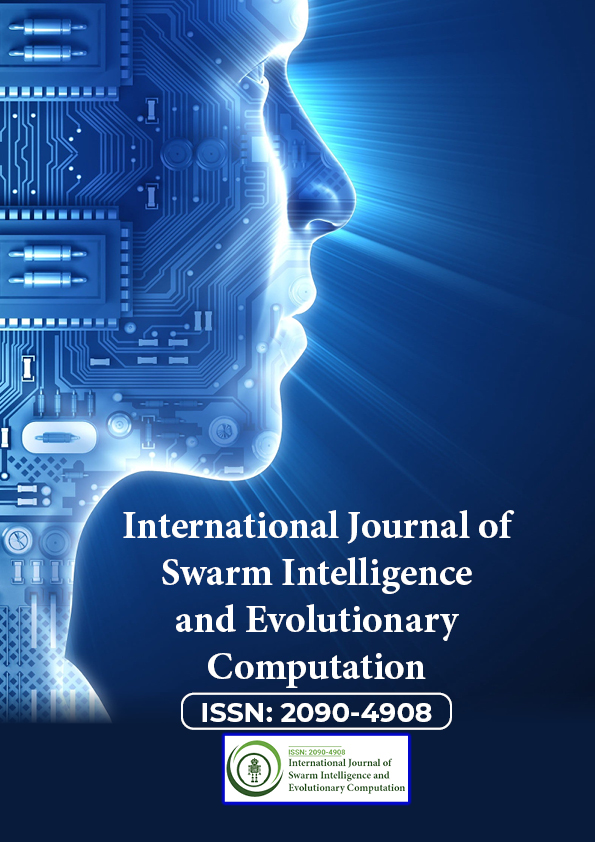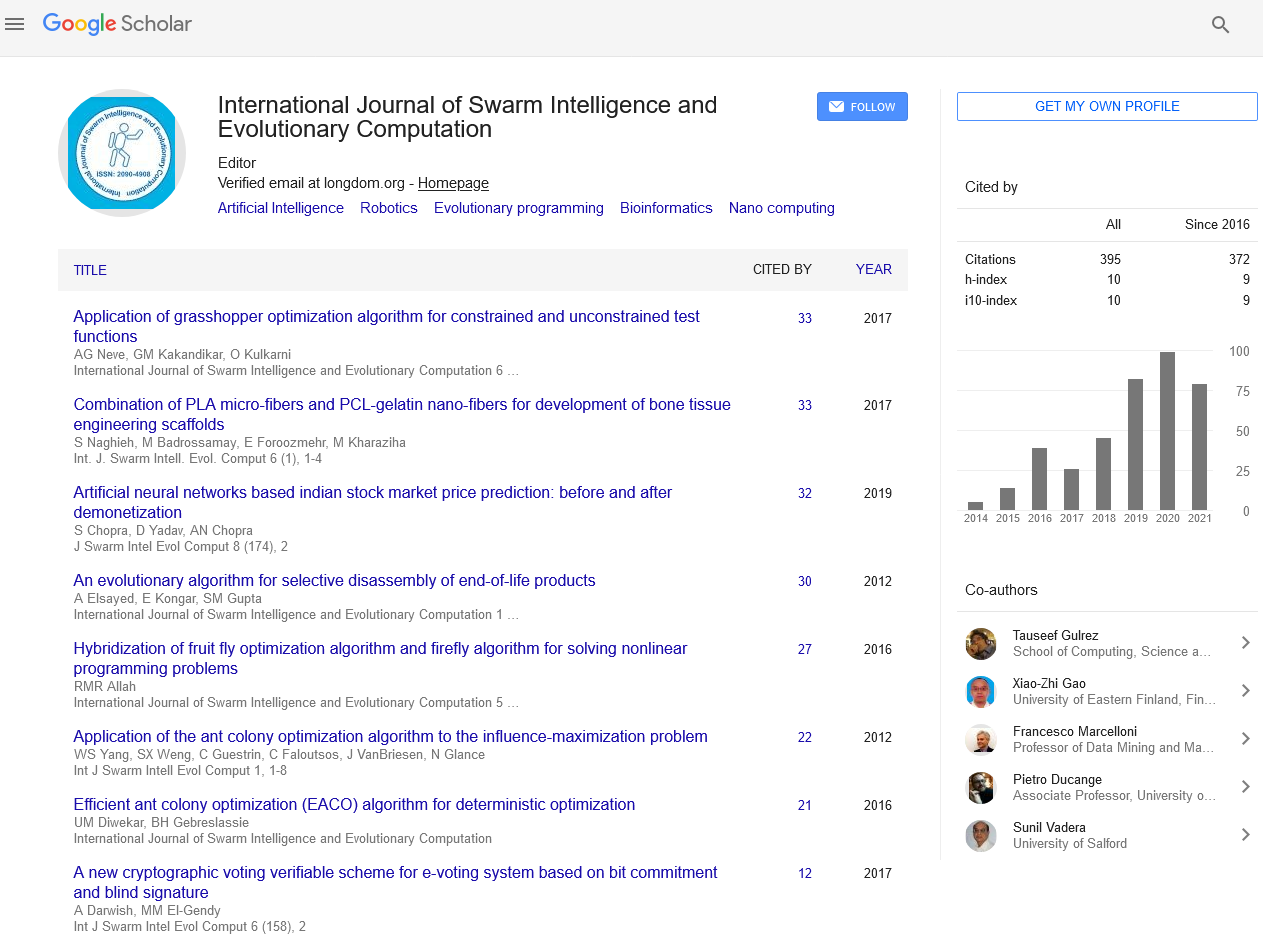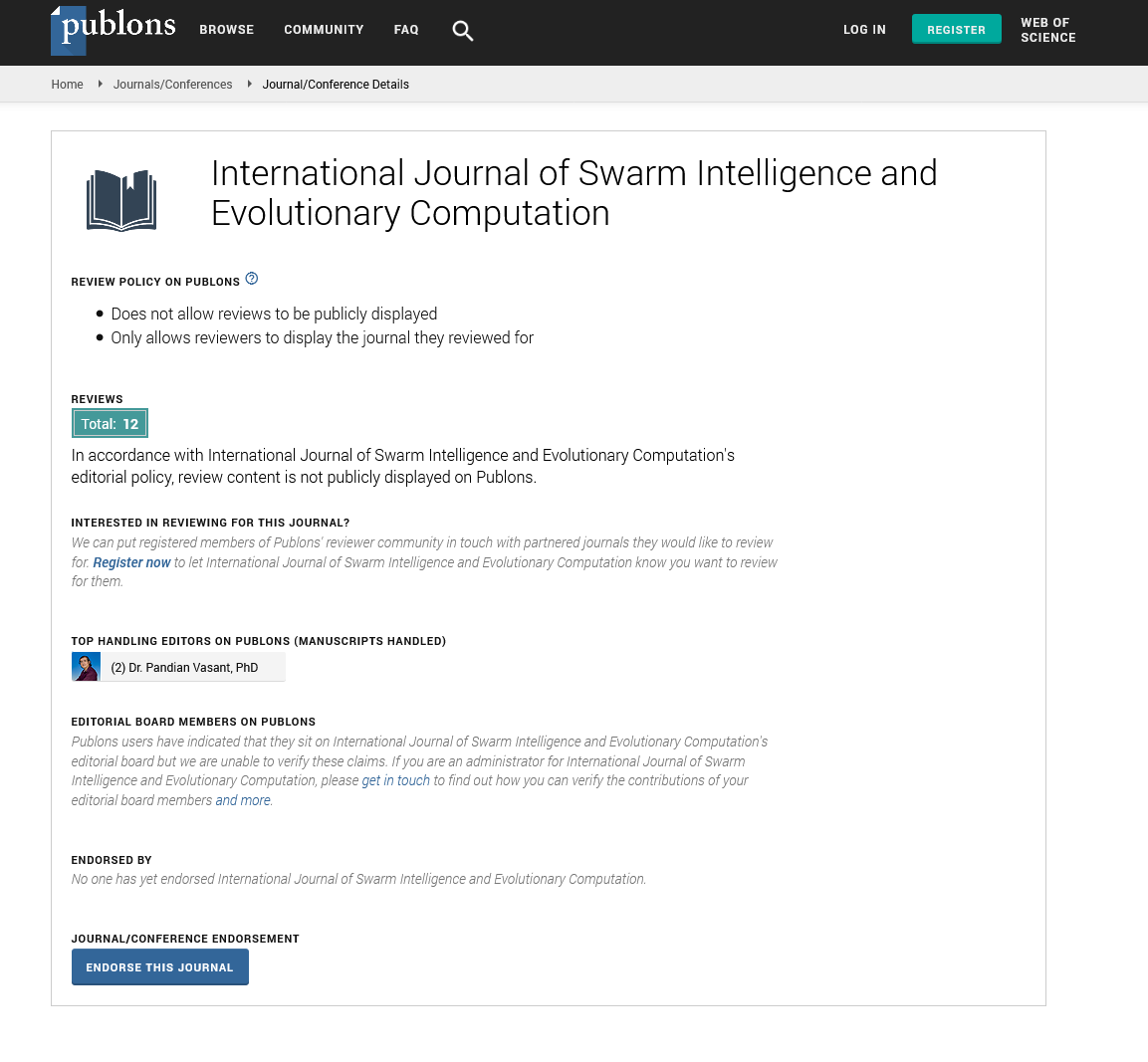Indexed In
- Genamics JournalSeek
- RefSeek
- Hamdard University
- EBSCO A-Z
- OCLC- WorldCat
- Publons
- Euro Pub
- Google Scholar
Useful Links
Share This Page
Journal Flyer

Open Access Journals
- Agri and Aquaculture
- Biochemistry
- Bioinformatics & Systems Biology
- Business & Management
- Chemistry
- Clinical Sciences
- Engineering
- Food & Nutrition
- General Science
- Genetics & Molecular Biology
- Immunology & Microbiology
- Medical Sciences
- Neuroscience & Psychology
- Nursing & Health Care
- Pharmaceutical Sciences
Perspective - (2024) Volume 13, Issue 4
Optimizing Solutions through Nature: An Exploration of Nature-Inspired Algorithms
Richard Willey*Received: 28-Jun-2024, Manuscript No. SIEC-24-26598; Editor assigned: 01-Jul-2024, Pre QC No. SIEC-24-26598 (PQ); Reviewed: 16-Jul-2024, QC No. SIEC-24-26598; Revised: 24-Jul-2024, Manuscript No. SIEC-24-26598 (R); Published: 31-Jul-2024, DOI: 10.35248/2090-4908.24.13.384
Description
Nature-inspired optimization algorithms have emerged as powerful tools for solving complex problems in various fields, including engineering, computer science, and economics. These algorithms mimic natural processes and behaviors observed in biological, physical, and social systems to find optimal solutions. The most prominent examples of such algorithms include Genetic Algorithms (GA), Particle Swarm Optimization (PSO), Ant Colony Optimization (ACO), and Artificial Bee Colony (ABC) optimization.
Genetic Algorithms (GA)
Genetic Algorithms, introduced by John Holland in the 1960s, are inspired by the process of natural selection. They use mechanisms akin to biological evolution, such as selection, crossover, and mutation, to evolve solutions to optimization problems.
Selection: This process mimics survival of the fittest, where the best solutions are selected for reproduction based on their fitness values.
Crossover: Also known as recombination, this process involves combining parts of two parent solutions to produce offspring with potentially better performance.
Mutation: Random changes are introduced to offspring solutions to maintain genetic diversity within the population, preventing premature convergence to local optima.
GAs have been successfully applied to a wide range of problems, including scheduling, design optimization, and machine learning. Their strength and ability to find global optima in complex search spaces make them particularly valuable.
Particle Swarm Optimization (PSO)
Particle Swarm Optimization, developed by James Kennedy and Russell Eberhart in 1995, is inspired by the social behavior of birds flocking or fish schooling. In PSO, a group of particles (potential solutions) moves through the search space, guided by their personal best positions and the best positions found by the swarm.
Initialization: A swarm of particles is initialized with random positions and velocities.
Evaluation: Each particle's fitness is evaluated based on the objective function.
Update: Particles update their velocities and positions based on their personal best positions and the global best position found by the swarm.
PSO is known for its simplicity and effectiveness in continuous optimization problems. It has been applied to various domains, including neural network training, function optimization, and engineering design.
Ant Colony Optimization (ACO)
Ant Colony Optimization, introduced by Marco Dorigo in the early 1990s, is inspired by the foraging behavior of ants. Ants deposit pheromones on the ground to communicate with each other, and this collective behavior helps them find the shortest paths to food sources.
Initialization: A number of artificial ants are placed in the search space.
Construction: Ants construct solutions by moving through the search space and making probabilistic decisions based on pheromone levels and heuristic information.
Pheromone update: After all ants have constructed their solutions, pheromones are updated to reinforce good solutions and evaporate pheromones on less favorable paths.
ACO has been particularly successful in solving combinatorial optimization problems such as the Traveling Salesman Problem (TSP), vehicle routing, and network routing.
Artificial Bee Colony (ABC) optimization
Artificial Bee Colony optimization, proposed by Dervis Karaboga in 2005, is inspired by the foraging behavior of honey bees. In ABC, the colony consists of used bees, onlookers, and scouts, each playing a specific role in the search for optimal solutions.
Initialization: A population of food sources (solutions) is randomly generated.
Onlooker bees: Onlookers watch the dances of used bees and choose food sources based on their quality (fitness).
Scout bees: Scouts randomly search for new food sources to replace abandoned ones.
ABC has been effectively applied to numerical optimization, pattern recognition, and clustering problems, demonstrating its versatility and efficiency.
Reasons for effectiveness
Nature-inspired optimization algorithms are effective for several reasons:
Adaptability: These algorithms can adapt to dynamic and complex environments, making them suitable for real-world problems where conditions change over time.
Parallelism: Many nature-inspired algorithms naturally lend themselves to parallel implementation, allowing for faster convergence and scalability to large problems.
Exploration and exploitation: They balance exploration (searching new areas of the search space) and exploitation (refining existing solutions), which helps in avoiding local optima and finding global solutions.
Simplicity and flexibility: These algorithms often have simple structures and can be easily modified or hybridized to suit specific problem requirements.
Applications
The applications of nature-inspired optimization algorithms are vast and diverse. They have been used in engineering design, such as optimizing the shapes of aerodynamic structures, in economics for portfolio optimization, in computer science for feature selection in machine learning, and in operations research for optimizing supply chains and logistics.
Conclusion
Nature-inspired optimization algorithms offer powerful, flexible, and efficient methods for solving complex optimization problems. By mimicking natural processes, these algorithms harness the power of evolution, social behavior, and foraging strategies to find optimal solutions in diverse and challenging search spaces. Their continued development and application hold great potential for tackling some of the most difficult problems in science and engineering.Citation: Willey R (2024) Optimizing Solutions through Nature: An Exploration of Nature-Inspired Algorithms. Int J Swarm Evol Comput.13:384.
Copyright: © 2024 Willey R. This is an open-access article distributed under the terms of the Creative Commons Attribution License, which permits unrestricted use, distribution, and reproduction in any medium, provided the original author and source are credited.


